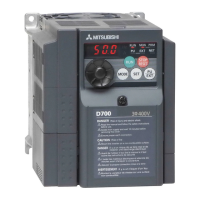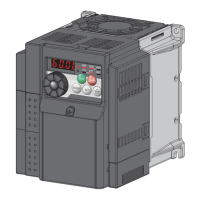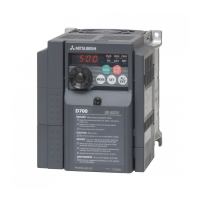What to do if Mitsubishi Electric FR-D720-2.2K shows PU disconnection?
- JJennifer AustinSep 6, 2025
This function stops the inverter output if communication between the inverter and PU is suspended. Connect the parameter unit cable securely.

What to do if Mitsubishi Electric FR-D720-2.2K shows PU disconnection?
This function stops the inverter output if communication between the inverter and PU is suspended. Connect the parameter unit cable securely.
What to do if Mitsubishi Electric FR-D720-2.2K Inverter has overcurrent trip during acceleration?
If the inverter output current reaches or exceeds approximately 200% of the rated current during acceleration, the protective circuit activates and shuts off the inverter output. You can increase the acceleration time. If "E.OC1" is always lit at starting, disconnect the motor and start the inverter. Check for output short-circuit/ground fault and set 50Hz in Pr. 3 Base frequency.
What causes Mitsubishi Electric Inverter overload trip and how to fix it?
The inverter output stops if the temperature of the output transistor element exceeds the protection level when a current not less than the inverter rated current flows and overcurrent trip does not occur (200% or less). To resolve this, increase the acceleration/deceleration time.
What does output current detection value exceeded mean on Mitsubishi Electric FR-D720-2.2K?
This function is activated when the output current exceeds the Pr. 150 Output current detection level setting. Check the settings of Pr. 150 Output current detection level.
What causes a stall prevention (overcurrent) on a Mitsubishi Electric FR-D720-2.2K and how to fix it?
The overcurrent stall prevention on your Mitsubishi Electric Inverter has been activated. To resolve this: * Increase or decrease the Pr. 0 Torque boost setting by 1% and check the motor status. * Set a larger value in Pr. 7 Acceleration time and Pr. 8 Deceleration time. * Reduce the load weight. * Try General-purpose magnetic flux vector control. * Adjust the Pr. 13 Starting frequency setting. * Change the Pr. 14 Load pattern selection setting. * Set the stall prevention operation current in Pr. 22 Stall prevention operation level.
How to resolve analog input fault on Mitsubishi Electric FR-D720-2.2K Inverter?
An analog input fault appears if voltage(current) is input to terminal 4 when the setting in Pr.267 Terminal 4 input selection and the setting of voltage/current input switch are different. Give a frequency command by current input or set Pr. 267 Terminal 4 input selection, and voltage/current input switch to voltage input.
What happens when Mitsubishi Electric FR-D720-2.2K has output phase loss?
If one of the three phases (U, V, W) on the inverter's output side (load side) is lost during inverter operation, the inverter stops the output. Ensure that the cables are wired properly.
What to do if my Mitsubishi Electric FR-D720-2.2K is showing overcurrent trip during constant speed?
If your Mitsubishi Electric Inverter is showing an overcurrent trip during constant speed operation, make sure the load is stable. Also, check the wiring for any output short circuits or ground faults. Try lowering the stall prevention operation level and activating both the stall prevention operation and the fast-response current limit operation (Pr.156).
What causes regenerative overvoltage trip during constant speed on Mitsubishi Electric Inverter?
If regenerative energy causes the inverter's internal main circuit DC voltage to reach or exceed the specified value, the protective circuit is activated to stop the inverter output. Ensure that you keep load stable.
What causes motor overload trip on Mitsubishi Electric FR-D720-2.2K Inverter?
The electronic thermal relay function in the inverter detects motor overheat due to overload or reduced cooling capability during low-speed operation. To resolve this, reduce the load weight.
| Series | FR-D700 |
|---|---|
| Model | FR-D720-2.2K |
| Rated Output Power | 2.2 kW |
| Rated Output Capacity | 2.2 kW |
| Frequency Range | 0.5-400 Hz |
| Applicable Motor Capacity | 2.2 kW |
| Protection Level | IP20 |
| Protective Structure | Open type |
| Overload Capacity | 150% for 60 seconds |
| Weight | 1.5 kg |
| Output Frequency Range | 0.5 to 400 Hz |
| Protection Features | Overcurrent, Overvoltage, Undervoltage |
| Input Voltage | 3-phase 200 to 240 V |
| Output Voltage | 3-phase 200 to 240 V |
| Control Method | Soft-PWM control/high carrier frequency PWM control (V/F control, advanced optimum torque control, vector control) |
Details on verifying inverter contents, identifying parts, and checking the serial number for order accuracy and integrity.
Illustrates the terminal connection diagrams for both main and control circuits, including power supply and motor wiring configurations.
Details the specifications for main circuit terminals, including power input, inverter output, brake resistor, and DC reactor connections.
Explains the functions, ratings, and connections for control circuit terminals, including input signals, output signals, communication, and safety stop.
Outlines critical safety instructions, handling procedures, wiring precautions, and operational considerations to prevent product damage or accidents.
Provides a comprehensive list of all inverter parameters, their functions, setting ranges, initial values, and cross-references for detailed information.
Explains how to adjust motor torque, starting torque, and low-speed torque using manual torque boost and magnetic flux vector control.
Covers motor protection methods like electronic thermal O/L relay and PTC thermistor protection, and how to apply auto-tuning for optimal motor performance.
Explains how to assign functions to input and output terminals, configure communication, and manage safety stop signals.
Describes functions for automatic restart after power failures and power-failure deceleration stop to ensure continuous operation or safe shutdown.
Explains how to configure retry operations, phase loss protection, and earth fault detection to manage and recover from faults.
Explains how to reset the inverter after a fault occurs, including procedures for different reset methods and clearing integrated thermal data.
Provides a comprehensive list of error messages, warnings, alarms, and faults displayed by the inverter, with corresponding page references.
Details common causes for error messages, warnings, and faults, along with specific corrective actions to resolve the issues.












